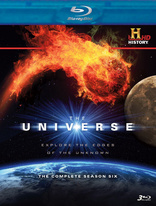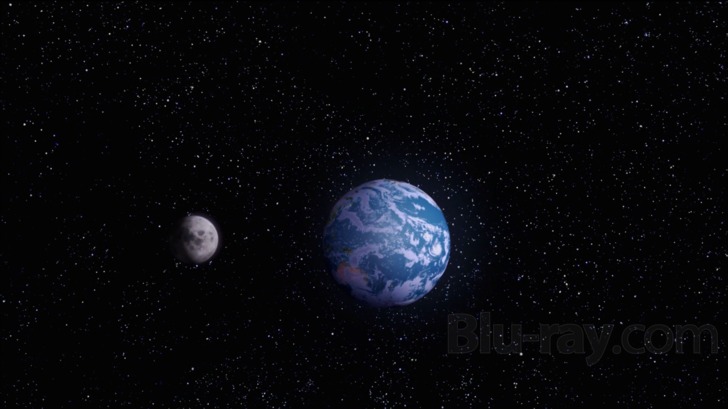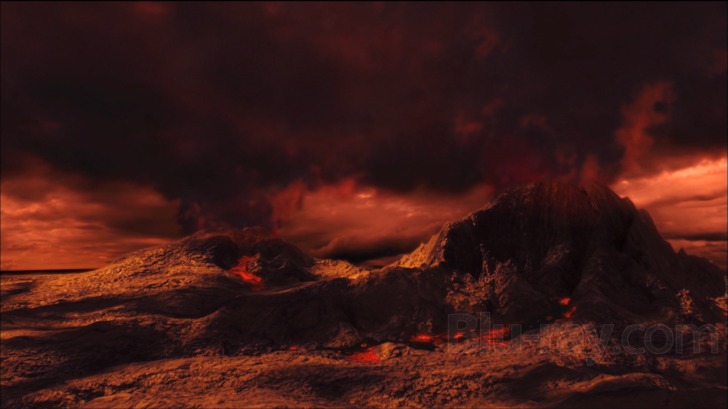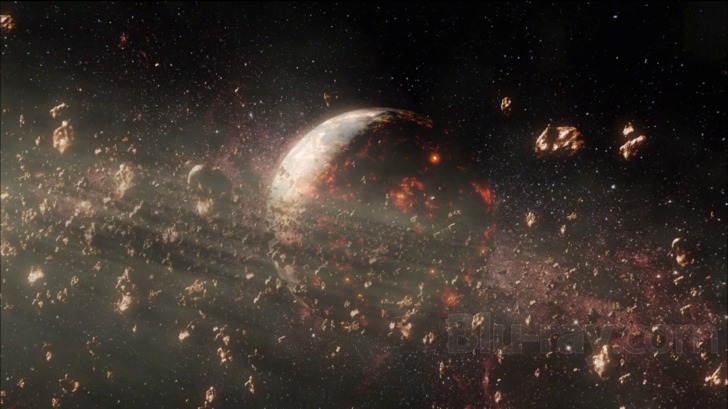The Universe: The Complete Season Six Blu-ray Movie
HomeThe Universe: The Complete Season Six Blu-ray Movie 
A+E Networks | 2011 | 658 min | Rated G | May 15, 2012
Movie rating
6.9 | / 10 |
Blu-ray rating
| Users | 0.0 | |
| Reviewer | 3.5 | |
| Overall | 3.5 |
Overview
The Universe: The Complete Season Six (2011)
Travel through the galaxies and explore extraterrestrial phenomenon with this sweeping examination of the universe from The History Channel, which uses state-of-the-art computer technology to take viewers up close to distant planets and stars. Topics include black holes, comets, alien galaxies, star deaths, the moon, the interior of the sun and much more. All 13 episodes from the first season are included, plus the bonus episode "Beyond the Big Bang."
Narrator: Erik Thompson| Documentary | Uncertain |
| Nature | Uncertain |
| History | Uncertain |
Specifications
Video
Video codec: MPEG-4 AVC
Video resolution: 1080p
Aspect ratio: 1.78:1
Original aspect ratio: 1.78:1
Audio
English: DTS-HD Master Audio 2.0
Subtitles
English
Discs
50GB Blu-ray Disc
Three-disc set (3 BDs)
Playback
Region A (B, C untested)
Review
Rating summary
| Movie | 3.0 | |
| Video | 4.5 | |
| Audio | 4.0 | |
| Extras | 0.0 | |
| Overall | 3.5 |
The Universe: The Complete Season Six Blu-ray Movie Review
Very little new under the sun (or anywhere else for that matter).
Reviewed by Jeffrey Kauffman April 23, 2012The Universe has been one of the more reliable series running on The History Channel for the past several
years, offering some great visuals and interesting information along the way, but it is also a somewhat problematic
series that has several issues which seem to be endemic to many History outings. First of all, it is relentlessly
apocalyptic at times, focusing on death and destruction and all manner of things that go bump in the vast night of outer
space. Second of all, it is incredibly repetitive at times, something that might seem to be peculiar when one considers
that entire universe (which is, after all, a very large place) is the subject of this series. But it can’t be denied
that our actual knowledge of the universe is relatively miniscule, meaning this series tends to tread and retread over
the same material repeatedly, trying to dress it up in different attire but never fully managing to avoid the fact that
longtime viewers will have been there and seen that. The previous seasons of The Universe were reviewed on
Blu-ray.com here:
The
Universe: The Complete Season One Blu-ray review
The
Universe: The Complete Season Two Blu-ray review
The
Universe: The Complete Season Three Blu-ray review
The
Universe: The Complete Season Four Blu-ray review
The
Universe: The Complete Season Five Blu-ray review

The Universe: The Complete Season Six includes the following 14 episodes spread over three Blu-ray discs:
Catastrophes That Changed the Planets. Once again it’s “Apocalypse Now” on The Universe, only this time on a solar system scale. This episode delves into how cataclysms in various epochs created and then altered planets and the general “neighborhood” around us. The chaotic nature of untold eons past is compared to a pinball machine, where planets were formed and destroyed with seemingly careless abandon. These cosmic disasters created virtually every aspect of our solar system, according to this episode. One of the more interesting facts that comes out in this outing is how the order of the planets as we now know it was once different and that at one point Jupiter and Saturn especially kind of “wandered around” before settling down into their current orbits. This is yet another “countdown” episode, which seeks to present the viewer with something like a Top 10 of cosmic calamities, counting down to a patently ridiculous Number 1, a potential “duel” between Jupiter and Mercury that might wreak havoc on Earth. Emphasis on might—this is yet another episode in this series where disaster is highlighted, and then a scientist comes along to inform us that the chances are exceedingly remote.
Nemesis: The Sun’s Evil Twin. There are some cynics who might be inclined to laugh out loud at the premise of this episode, a premise which posits a dim red star (which is only suspected of existing) which every, oh, 26 million years or so triggers untold disasters, mostly by flinging comets from the wonderfully named Oort Cloud toward the Earth. This is another massively hypothetical episode that nonetheless is rather compelling, and which has some interesting sidebars, such as the development of a cosmic sleuth system known as WIDE (Wide-field Infrared Survey Explorer), which, if it’s ever launched, should be able to find Nemesis since it reads heat rather than light. There’s also a segment on a world that few have probably heard of, an ancient planetoid named Sedna whose radically changing orbit may hint at the nefarious activity of Nemesis.
How the Solar System Was Made. Haven’t we been down this Milky Way before? This is an undeniably informative episode, but it just smacks of what is so problematic about The Universe, namely, they just keep covering the same information over and over in slightly repackaged ways. Here we’re once again treated to the development of our solar system, and the “gimmick” this time is that they use a timeline to chart the course of that development over 700 million years. This episode benefits mightily from some great looking CGI, which is often almost three dimensional in its effectiveness, especially as it depicts huge floating rocks in space. There’s also some interesting information about the “proto-planet” that trailed Earth in eons past, Thea. But for anyone who’s been a fan of The Universe from its first episode, this is going to seem like awfully stale material for the most part.
Crash Landing on Mars is perhaps one of the most ridiculous episodes of this season, one which may in fact lead some people to just throw up their arms in frustration and turn the damn thing off. Instead of focusing on a manned expedition to Mars, this episode chooses to focus on what might go wrong if the first manned expedition crash lands on the planet. Full of silly doomsday scenarios and silly hypotheticals, this episode pretty much completely misses the mark and highlights some of the glaring defects that The Universe seems to be falling into more and more as it proceeds along. At least this episode has some nice clips from cheesy sci-fi movies from decades past where astronauts crash on Mars.
Worst Days on Planet Earth is another sad entry into The Universe’s annoying tendency to focus on apocalyptic issues, not to mention couching them in “countdown” episodes. Here we get the “seven worst days on Planet Earth,” a litany of disasters that have befallen our beloved orb. We get everything from volcanic eruptions to Ice Ages to the Ordovician Extinction, counting down to Number 1 with a bullet (and/or a solar flare, as the case may be), yet another accounting of the sun’s annihilation of all earthly live in a mere five billion years or so. Evidently the Mayans were off by a little bit.
God and the Universe begins to at least partially redeem (no pun intended) this season with an interesting look at creation theory and whether a Divine Creator or “mere” physics can account for anything. The episode gets off to a promising start by showing the viewer both the cataclysmic destruction that takes place throughout space, contrasted with the rather extraordinary amount of life on our planet, and then posits the question: how could this huge disparity have come into being? While the episode doesn’t really give any ultimate answers (how could it, really?), it does a fairly well modulated job of ping ponging emerging hypotheses (like string theory) with ancient beliefs of an omnipotent creator. Religious types will no doubt notice that the portentous narration “evolves” (again, pun intended) from mentioning “God” to “a god”, something which must might rankle the Almighty. The episode does devolve slightly at the end with a sidebar dealing with the possibility of ancient alien cultures seeding our planet, a la Erich van Däniken’s Chariots of the Gods.
UFOs: The Real Deal is kind of a fun recounting of several big sightings through the years, beginning with the June 24, 1947 flight by Kenneth Arnold over Mt. Rainier in Washington state, a flight that began the whole flying saucer mania. A reporter actually misquoted Arnold, who had said the craft he witnessed “moved like saucers skipping on water,” which morphed into flying saucers and forever entered the public lexicon. There is of course copious time given over to Roswell, as well as several sightings in outer space in the background of space missions, including a July 19, 2009 space shuttle Endeavor flight where something is clearly seen in the background hovering above the ship’s robotic arm. There’s also some nice archival footage from the well publicized mass sighting on March 13, 1997 in Arizona.
How Big, How Far, How Fast. This is what The Universe really should be about: helping everyday viewers understand the complex data of science, especially when that data is mind boggling, to say the least. What this episode tries to do is to reduce the vast sizes, distances and speeds of the universe to human scale, hopefully making them more comprehensible in the process. While this episode is full to the brim with comparisons (the sun is 300,000 times as heavy as the Earth, for example), there are also some cogent examples of various concepts. While my regular Universe nemesis Alex Filippenko gets the “duh” Comment of the Year award with his statement, “The speed of light is really fast”, he at least goes on to give a salient example by showing that light could bounce back and forth between Los Angeles and New York 38 times in a second.
Our Place in the Milky Way once again revisits information that The Universe has covered previously (several times, in fact), something made all the more maddening by the fact that it turns out scientists aren’t really sure where we are in the Milky Way. Our predicament is likened to that of a rat in a maze, the poor beast able to traverse pathways but never cognizant of what the whole “pattern” looks like. It almost gets ludicrously funny at times in this episode as various scientists admit that not only do we not know where we are in the Milky Way, we don’t even know what the Milky Way really looks like. Some posit two spiral arms, others four, and the simple fact is no one knows for sure. The best part of this episode is some of the names of celestial matter, including a cloud known as The Local Fluff.
Alien Sounds begins with that iconic tag line from Alien, “In space no one can hear you scream,” but then gets into a kind of ridiculously technical examination of defining what “space” means. Does an astronaut on the surface of Mars consider himself in space? There’s some silly but undeniably entertaining segments in this episode, including a completely inane but funny bit with a researcher name Bruce Betts who has developed a computer program to approximate what voices would sound like on Mars. His contraption is called The Marsinator, and it ends up slowing down speech and making it sound like a drug fueled, bass heavy version of his normal speaking voice. Mr. Betts evidently has way too much time on his hands. There is some interesting analysis here of the physics of acoustics, but this is yet another “countdown” episode (here done as a sort of quasi-Casey Kasem outing), leading (of course) to Number 1 being the many sounds from planet Earth. Not exactly alien, you say? Well sleight of hand can do wonders: if aliens are in outer space listening to sounds emanating from our planet, that makes those sounds alien to them. Got it?
Deep Freeze deals with the coldest places in the universe but in typically anachronistic fashion starts out with the hottest event known to Man (or at least suspected by Man), the Big Bang, which was evidently 100 million trillion trillion kelvins. A lot of this episode concentrates on the New Horizons mission to Pluto which has the kind of interesting addition of enlisting every day armchair scientists to sort through countless star images to help select where New Horizons should aim for after it completes its survey of Pluto. Some of the scientists here reveal their film geek side by mentioning things like Hoth, the ice planet from The Empire Strikes Back. Once again we get the cheery news that we’re all headed for annihilation (in countless billion years, of course) since all energy in the universe is slowly but surely dissipating.
Microscopic Universe is actually one of the more interesting episodes from this season, if only because it ventures into a different sort of universe, the one of subatomic particle and quantum physics. The fact that this particular universe is so nonintuitive is explored, with a number of paradoxes looked at with a fair degree of comprehensibility and visual flair. Those who grew up reading books like The Tao of Physics or The Dancing Wu Li Masters will no doubt recognize many of the concepts covered in this episode, but this is a fun and informative outing that at least doesn’t endlessly rehash items that have already been done to death before.
Ride the Comet reviews some of the beliefs of ancient cultures who would witness fireballs traversing the sky, and then uses the gimmick of a super hi-tech spacecraft shadowing a comet to uncover information about how comets are formed and how they zoom through space, covering a huge expanse in the process, from the Kuiper Belt to our sun. There’s some nice information about the relatively recent Deep Impact mission that sent a projectile directly into Tempel 1, spewing huge amounts of debris out into space and finally allowing scientists a chance to investigate what’s inside these icy planetoids. There’s also a segment on the Oort Cloud which contains perhaps over a trillion comets.
When Space Changed History. It’s death and destruction again, but at least this time there’s a relative novelty of this episode focusing on a bunch of scientific outcasts, a coterie of civilians who are attempting to prove that comets hit the earth circa 535 A.D., causing a well documented dimming of the sun for well over a year, resulting in the most severe cooling period our planet has experienced over the past two thousand or so years. The Holocene Working Impact Group, as the aggregation is known, may not have the imprimatur of well established traditional organizations, but they’re an interesting lot who just might have stumbled onto some fascinating information. There are a number of other cataclysms explored here (you expected anything less with The Universe), including the Biblical flood of Noah and the somewhat similar Epic of Gilgamesh, as well as the extermination of the Clovis Culture and Emperor Constantine’s “vision” which led to his conversion.
The Universe: The Complete Season Six Blu-ray Movie, Video Quality 

The Universe: The Complete Season Six is presented on Blu-ray courtesy of A + E Home Entertainment Networks with an AVC encoded 1080p transfer in 1.78:1. As is usual with this series, this is yet another spectacular looking outing full of some really amazing looking CGI that masterfully recreates huge spiral nebulae and other fascinating looking cosmic phenomena. Colors are bright, bold and vivid, and the image is uniformly sharp in these sequences, as it is (perhaps to a slightly less awesome degree) in the contemporary interview segments. There is occasional archival footage here which can seem overly grainy, fuzzy and soft by comparison, but overall this is yet another stellar (sorry) looking release from this always engagingly visual series.
The Universe: The Complete Season Six Blu-ray Movie, Audio Quality 

It's a little surprising that The Universe: The Complete Season Six features only a lossless DTS-HD Master Audio 2.0 stereo mix, for this is one series that exults in busy sound effects, planets whooshing to and fro, space craft zooming through the furthest reaches of the galaxy, and other wacky and wonderful sonic activity. A surround mix certainly could have helped up the aural experience here, but what we do have is remarkably clear and fluid fidelity, anchored by the front and center narration and talking heads segments. The soundtracks of various episodes can get rather noisy at times, something that a surround mix might have added at least a little spaciousness to, but overall this is a nicely modulated and well mixed track that gets the job done well.
The Universe: The Complete Season Six Blu-ray Movie, Special Features and Extras 

No supplements are included on this three disc set.
The Universe: The Complete Season Six Blu-ray Movie, Overall Score and Recommendation 

Casual viewers of The Universe will probably enjoy this season much more than this curmudgeonly reviewer, who has had to sit through all six seasons now for professional purposes. Watching this series one episode after another can be a maddeningly repetitive affair and it makes the show's focus on doom and gloom as well as its repeated gimmicks like countdown episodes all the more apparent. But even casual viewers may well start to wonder why this series goes back to the same well over and over, simply trying to repackaging information that's already been given previously in some sort of semi-shiny new package. How many times do we need to be told the sun is going to explode and kill everyone? Evidently quite a few, at least if we take The Universe at face value. This season does boast typically elegant CGI and a nicely done soundtrack. It's hard to recommend this season outright since so much of it covers information that has been covered in the previous five seasons, but for armchair scientists who enjoy the show, this Blu-ray will probably do the trick quite nicely.
Other editions
The Universe: Other Seasons

The Universe: The Complete Season One
2007

The Universe: The Complete Season Two
2008

The Universe: The Complete Season Three
2008

The Universe: The Complete Season Four
2009

The Universe: The Complete Season Five
2009

The Universe: 7 Wonders of the Solar System 3D
2010

The Universe in 3D
2011

The Universe: The Complete Season Seven
Ancient Mysteries Solved
2013
Similar titles
Similar titles you might also like

Wild Ocean
IMAX
2008

Dinosaurs Alive!
IMAX
2007

Journey to the Edge of the Universe
2009

IMAX: Hubble 3D
2010

Grand Canyon Adventure: River at Risk 3D
IMAX 3D
2008

Mummies: Secret of the Pharaohs
IMAX
2007

Ocean Wonderland 3D
2003

History of the World in Two Hours 3D
2011

Space Station 3D
IMAX
2002

Deep Sea 3D
IMAX
2006

When We Left Earth: The NASA Missions
2007

Under the Sea
IMAX
2009

3D Safari: Africa
2011

Sharks 3D
2004

Galápagos
2006

The Ultimate Wave: Tahiti 3D
IMAX
2010

Wonders of the Solar System
2010

WWII in 3D
2011

The Universe in 3D: A Whole New Dimension
2013

Legends of Flight 3D
IMAX
2010